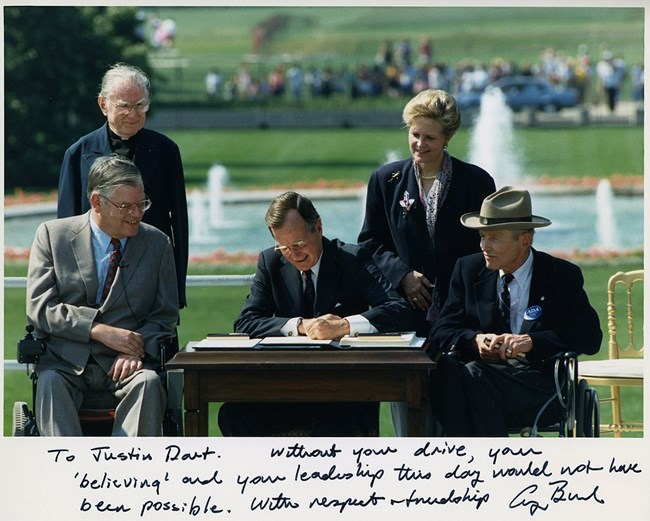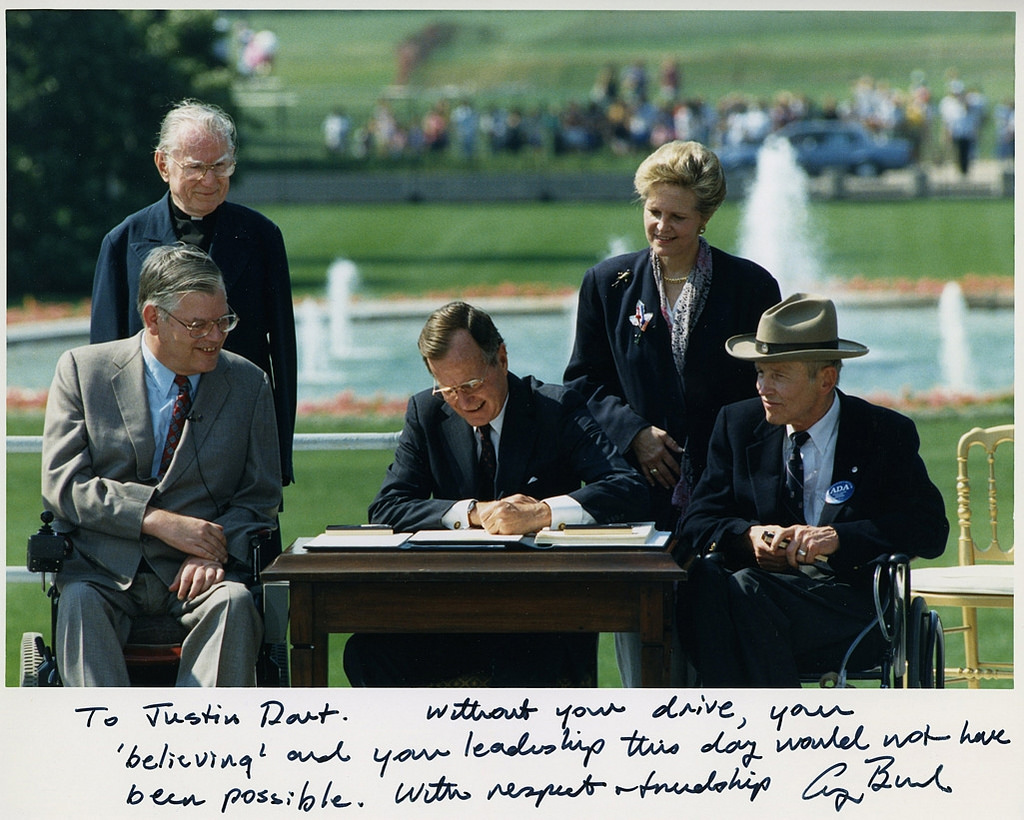
President George H.W. Bush signs the Americans with Disabilities Act. Photograph presented to Justin Dart Jr. in 1990.
Image by National Museum of American History (CC BY-SA 2.0; https://www.flickr.com/photos/nationalmuseumofamericanhistory/20825041956/)
The way disabilities are treated and perceived has changed since the 1900s. This has happened primarily because people with disabilities have demanded and created change. Like other civil rights movements, the disability rights movement has a long history. Examples of activism can be found among various disability groups dating back to the 1800s. Many events, laws, and people have shaped this evolution. To date, the Americans with Disabilities Act (ADA) of 1990 and the subsequent ADA Amendments Act (2008) are the movement’s greatest legal achievements. The ADA is a major civil rights law that prohibits discrimination against people with disabilities in many aspects of public life. The disability rights movement continues to work hard for equal rights.
Organizations for people with disabilities, by people with disabilities, have been around since the 1800s, but they exploded in popularity in the 1900s. The National League for the Physically Handicapped formed in the 1930s and fought for jobs during the Great Depression, and in the 1940s a group of people with mental illnesses came together to form “We Are Not Alone.”[2] They helped patients transitioning from the hospital to the community. In 1950, several community groups came together to form the National Association for Retarded Children (NARC). By 1960, NARC had tens of thousands of members, most of them parents, who were dedicated to finding alternative care and education methods for children.[3] Meanwhile, in the 1900s, support for people with disabilities was provided through the leadership of various presidents: President Truman established the National Institute of Mental Health in 1948. Between 1960 and 1963, President Kennedy organized several planning committees to treat and research disabilities.[3]
The U.S. Congress has passed many laws that support the rights of people with disabilities, either directly or by recognizing and enforcing civil rights. Civil rights laws such as Brown v. Board of Education and the ruling that racial segregation in schools was unconstitutional laid the foundation for recognizing the rights of people with disabilities. Several provisions of the Rehabilitation Act of 1973 specifically address disability discrimination and are of particular importance to the disability rights movement. Section 501 supports people with disabilities in federal workplaces and any organization that receives federal tax revenue. Section 503 requires affirmative action measures to support the employment and education of members of traditionally disadvantaged minority groups. Section 504 prohibits discrimination against people with disabilities in the workplace and in programs and activities. Section 508 ensures that people with disabilities have equal or equal access to technical information and data. The regulations for Section 504 of the Rehabilitation Act of 1973 were written but not implemented. In 1977, disability rights groups grew impatient and called on President Carter to sign the regulations. Instead, a special committee was appointed to review these provisions. Fearing that this review would weaken the law’s protections, the Americans with Disabilities Council (ACCD) insisted that they take action if the provisions were not implemented as written by April 5, 1977. When the deadline came and the regulations remained unsigned, people across the country staged sit-ins at the federal Department of Health, Education, and Welfare (the agency in charge of the review). In San Francisco, the sit-in at the federal building continued until April 28, the day the regulations were finally signed without changes. According to organizer Kitty Kohn, this was the first time “disability was truly considered as a civil rights issue, rather than a matter of charity or rehabilitation at best, or sympathy at worst.”[4]
The Handicapped Children Education Act of 1975 guaranteed children with disabilities the right to an education in public schools. These laws were passed primarily through the concerted efforts of disability activists who campaigned for disability rights and worked with the federal government. In total, the U.S. Congress passed more than 50 bills between the 1960s and the passage of the ADA in 1990.
Self-advocacy groups have also shaped the national discussion on disability. Self-advocacy means representing your own interests. Such groups include DREDF (Disability Rights Education and Defense Fund), ADAPT (American Association of Disabled People Advocating for Public Transportation, later changed to American Disability Assistance Programs Today), and CIL (Center for Independent Living). CIL serves people with disabilities in their communities. CIL began in the early 1960s at Cowell Memorial Hospital, a California hospital that was once listed on the National Register of Historic Places. The building has now been demolished, but its legacy remains. The hospital supported the “Rolling Quad” and “Disabled Student Programs” at the University of California, Berkeley. Both organizations were founded by students Ed Roberts and John Hessler. Both men lived with physical disabilities and needed to find housing options after enrolling in college. College dorms could not accommodate Roberts’ iron lung, an auxiliary breathing device for polio patients, or Hessler’s physical needs. When Hessler and Roberts enrolled in college in the early 1960s, they lived instead at Cowell Memorial Hospital. With the support of Jeanne Worth, a counselor at San Mateo, they demanded access to their school and encouraged other students with physical disabilities to attend UC Berkeley. They also influenced the architecture and planning of the school. UC Berkeley eventually created a housing facility for these students. It was also at this time that the students planted the seeds of the independent living movement. The independent living movement supports the idea that people with disabilities can make their own decisions about how they live, work, and interact with their surrounding communities. The movement is a reaction to centuries of assisted living, psychiatric hospitals, and doctors and parents who made decisions for people with disabilities.
Roberts, Hessler, and Wirth founded the Student with Disabilities Program at UC Berkeley. It was not the first program of its kind. The state of Illinois had offered similar services since the 1940s, but UC Berkeley’s program was groundbreaking. It promoted inclusion for all students on campus. It inspired similar organizations at universities across the country, many of which are still active today.

